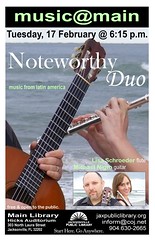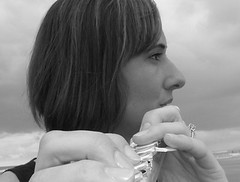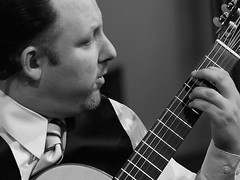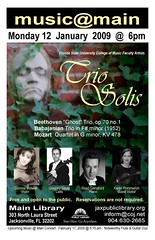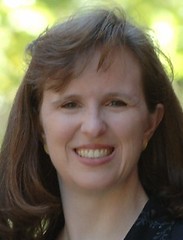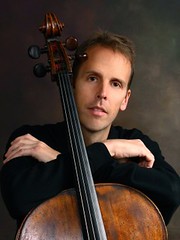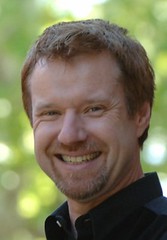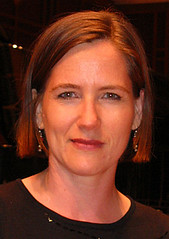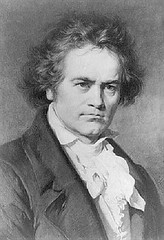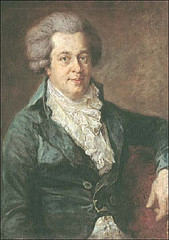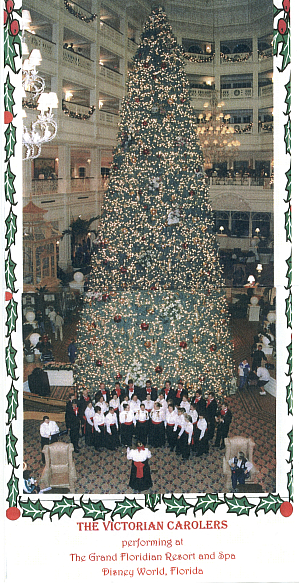Flutist Lisa Schroeder and classical guitarist Michael Nigro present a program of Latin American music that focuses on composers from Argentina, Brazil and Puerto Rico.
Their vision is to reach a non-classical audience while at the same time inspiring the classical listener, and to touch individuals with "noteworthy" performances. Since the summer of 2008, the Duo has toured Nevada and Colorado playing concert venues, television programs and radio shows, and their continuing tour schedule includes performances in California, Florida, Georgia, Wisconsin, Illinois, Missouri, Arizona, New Mexico, and Indiana. Noteworthy Duo's debut CD is entitled Between Guitar and Flute, and is scheduled for release in February 2009. Lisa and Michael are both on faculty at Vanguard University of Southern California.
More at noteworthyduo.com -- NOTE: for musical excerpts from this program click on their "MP3" tab!
PROGRAM
Progresiones para Pauline / José Luis Merlin (b.1952, Argentina)
Vidalita / Raúl Maldonado (b.1933, Argentina)
Entre guitarra y voz / Ernesto Cordero (b.1946, New York, raised in Puerto Rico)
Suite del recuerdo / José Luis Merlin
Evocación - Zamba - Chacarera -
Paçoca (Chôro) - Piazza Vittorio (Chôro Maxixe)
Études tanguistiques for Flute Solo. No.3: Molto marcato e energico / Ástor Piazzolla (1921-1992, Argentina)
L'histoire du tango / Ástor Piazzolla
Bordel 1900 - Café 1930 - Nightclub 1960 - Concert d’aujourd’hui
Flutist Lisa Schroeder is a Los Angeles based performer, teacher, and clinician. While completing her Bachelor of Music degree in flute performance from Middle Tennessee State University, Lisa gained experience in performing, teaching, and recording session work with area singer/songwriters, and she played piccolo with the Tennessee Philharmonic and flute with the Music City Winds. At the invitation of Dr. John Barcellona, Ms. Schroeder earned her Master of Music degree in flute performance from California State University Long Beach. Lisa is the founding member of Noteworthy Flute and Guitar Duo and West Coast Winds, both of which are on the artist roster for the Orange County (California) Performing Arts Center "Arts Teach" program, and she is the acting principal flutist with the Golden State Pops Orchestra. Ms. Schroeder currently teaches flute at Vanguard University, Cerritos College and Golden West College, and she directs the Rolling Hills Flute Choir. Her passion for teaching has brought about her annual "Flute Loops" camp held in Palos Verdes, California, and in August 2008 Lisa performed bass flute with the National Flute Association’s Professional Flute Choir at their Kansas City Convention.
Michael Anthony Nigro earned his Bachelor of Music at Indiana University School of Music under the direction of Ernesto Bitetti, and his Master of Music degree at California State University, Fullerton, under the tutelage of David Grimes. Michael Nigro’s debut recording, Homage to Piazzolla : Argentine Dances, Songs, and Rhythms, released on the Music & Arts label, earned praise from The American Record Guide, which observed, "Nigro has a big sound, a smooth tone, and sure-footed interpretive instincts." His latest CD, Guitar Sudamericana released by Balcon Records (Austria), features guitar works by a number of South Americn composers including Heitor Villa-Lobos, Antonio Lauro, Adolfo Luna, and Jose Luis Merlin. Much sought after as performer and teacher, Michael has played concerts around the country and has given master classes at numerous colleges and universities. He is co-founder of the Long Beach Classical Guitar Society and an independent reviewer of new music publications for Soundboard Magazine. Michael joined the faculty at Vanguard University of Southern California in January 2006, teaching private guitar, class guitar, and guitar ensemble.
Program Notes by Ed Lein, Music Librarian
Argentine composer José Luis Merlin (b. 1952) began studying the guitar when he was 5 years old, and was performing publicly by age 9. He is currently the Director of the Mundo-Valesquez School of Music in Madrid, Spain, where he also teaches guitar. Merlin has toured extensively throughout North and South America and Europe, and has released over ten CDs in Argentina, the USA, Australia and Japan. His compositions often feature his own instrument, and he typically draws inspiration from Argentine folk music. Progresiones para Pauline is dedicated to the memory of Pauline Lasse, who worked in Eugene, Oregon, for the Council on Human Rights in Latin America, but rather than mourning the passing of his dear friend, the composer celebrates her life. Merlin certainly lives up to his name with the "magically" evocative Suite del recuerdo ("Suite of Remembrance"), one of his most popular works, and one which celebrates a variety of South American folk songs and dances. Originally for guitar solo, the composer conveniently adapted the initial Evocación and the final Joropo for flute and guitar, so Lisa joins Michael for the outer movements. [CLICK HERE to watch a video of the composer performing the solo version of the suite.]
Raúl Maldonado (b.1937) has been active internationally as a lecturer on music from his native Argentina, as a guitar soloist and member of several different guitar ensembles including the Atahualpa Quartet, and as the leader of his own orchestra. Not surprisingly, his several dozen published compositions almost always include one to six guitars, sometimes in combination with voice or other instruments, and they enjoy frequent performances around the globe. Vidalita, patterned after a type of melancholy folk song sung by Argentine gauchos (i.e., cowboys), is one of several works written in collaboration with fellow countryman Enzo Gieco, a composer, flutist and conductor, and the piece is also published for clarinet and guitar.
Although composer and guitarist Ernesto Cordero (b. 1946) was born in New York, he grew up in Puerto Rico and joined the guitar and composition faculty at the University of Puerto Rico in 1971. His works often draw inspiration from the folk music of the Caribbean, and particularly from the Afro-Hispanic music of Puerto Rico. Like many guitarists he favors his own instrument when composing, and his catalog includes six concertos (three for guitar, one for violin/mandolin, one for flute-piccolo and one for the Puerto Rican cuatro), a variety of chamber works with guitar, as well as solos pieces. The recipient of several important composition awards, his music is performed and recorded woldwide, and he is in demand as a participant in international competitions and festivals for the guitar. Entre guitarra y voz ("Between Guitar and Voice") is from Two Sentimental Songs (1996), and, as one might guess, was originally for voice and guitar.
Celso Machado (b. 1953) has been living in Vancouver since 1989, but he is originally from Brazil. The decision to become a professional musician was an easy one: his father was a guitarist and band leader in Brazil, and five of his six brothers are also musicians. Celso himself began playing in street bands when he was 7 years old, and although he performs internationally as a guitar virtuoso, he plays percussion and other instruments as well. His recordings are critically acclaimed, and for the film In the Company of Fear he won a Canadian Leo Award for Best Musical Score for Documentary in 2000. The music and rhythms of his homeland continue to permeate his music, but he also includes other folk traditions among his influences, and he has collaborated extensively with Chinese pipa (lute) player Qiu Xia He. The chôro form, used in the pieces on this evening's program, is the oldest and perhaps most important musical form associated with Brazil, and from it developed the popular samba of the 1960s. Even though the term "chôro" originally referred to "a cry of lament," chôros are often happy, lively virtuoso pieces, and they have long been associated with flute and guitar. The titles of these pieces indicate the composer's inspiration: " Paçoca" is a traditional Brazilian food, sometimes sweet, sometimes savory, but always including cassava flour (i.e., tapioca); and "Piazza Vittorio" shares its name with the famous public square in Rome.
Ástor Piazzolla (1921-1992) pretty much single-handedly reinvented the Argentine national dance, the tango, transforming it into a new style aptly called nuevo tango ("new tango"). Born in Argentina, Piazzolla spent most of his childhood in New York, and there he gained exposure to and a fondness for jazz and classical music. But through his father's influence he also gained proficiency on the bandoneón, a type of concertina that is a staple of Argentine tango ensembles, and when he returned to Argentina in 1937 he played with some of the leading bands in Buenos Aires. He also began the serious study of composition with noted composer Alberto Ginastera, and for an early symphony he won a grant in 1953 from the French government to study in Paris with legendary composition teacher Nadia Boulanger. Boulanger, whose illustrious students ranged from Aaron Copland and Elliott Carter to Quincy Jones and Burt Bacharach, found Piazzolla's music was well-crafted but too derivative of Bartók, Stravinsky and Ravel. When she finally got him to play for her some of the music he wrote for his cabaret band, she convinced him to toss out his other works and concentrate on what was uniquely his own. When he returned to Argentina in 1955, his "new tango," which infused traditional elements with characteristics of jazz and incorporated contrapuntal techniques and formal elements adapted from his classical studies, was met with resistance in his homeland, but Europeans and North Americans were captivated by it and his international career blossomed. It is estimated that he composed over a staggering 3,000 pieces, and he recorded about 500 of them himself! Piazzolla's six Études tanguistiques ("Tango Studies") were composed in 1987, and have also become popular in a transcription for solo violin. The 3rd Étude is a florid virtuoso piece with quickly shifting textures that sometimes give the impression that more than one flute is playing! The first two movements of the flute and guitar suite L'histoire du tango (History of the Tango) trace the development of the tango from its early roots at the fringes of society (Bordel 1900) to the somewhat more polite style that became the most popular dance throughout the whole of Argentina (Café 1930). The last two movements exemplify Piazzollo's own significant contributions to the form, with his revolutionary inclusion of elements from jazz (Nightclub 1960), to Concert d’aujourd’hui ("Concert of Today") in which he adapts the dance into his own brand of classical concert music of the 1980s.
